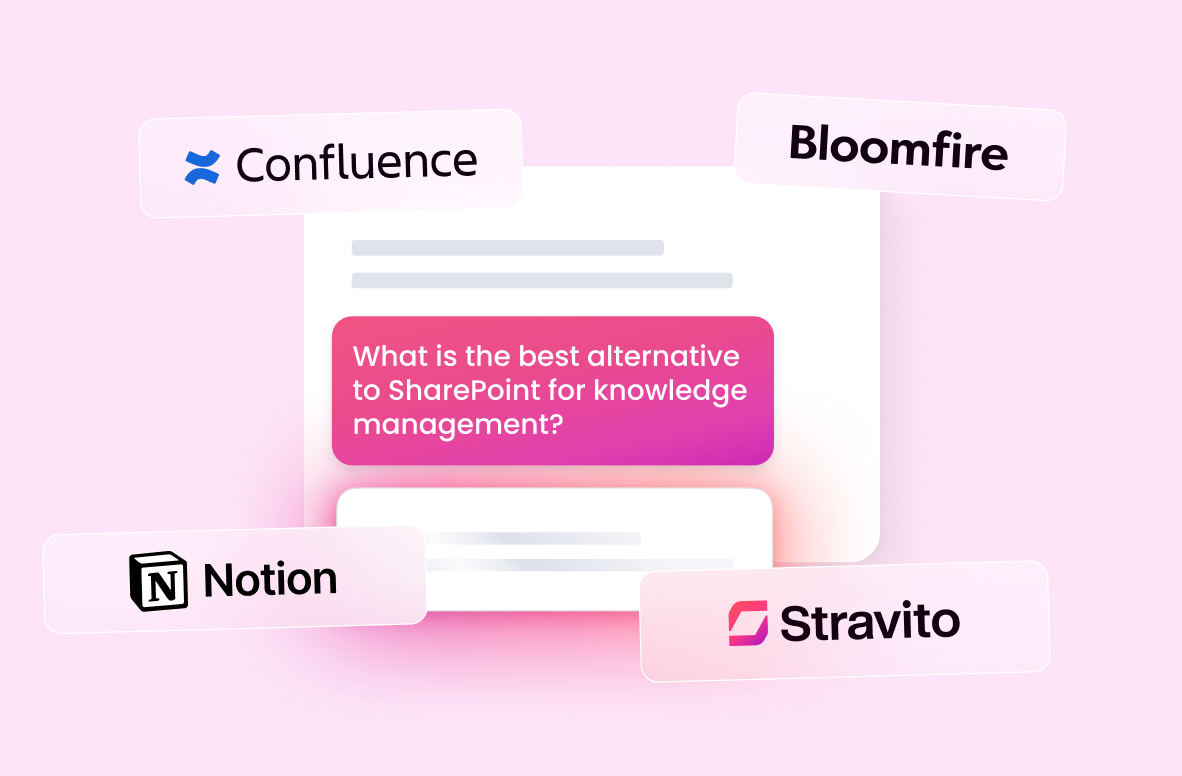TL;DR: Your 30-second overview
Here’s your 30-second overview:
- SharePoint remains popular, but many enterprises struggle with its steep learning curve, siloed setup, and low adoption.
- There are several strong SharePoint alternatives in 2025, ranging from collaboration tools and document management platforms to purpose-built knowledge management systems.
- This guide walks you through the best alternatives to SharePoint, what to look for in a platform, and how to make the business case for switching.
- We’ll also show why enterprises like Reckitt and NPR chose Stravito as a modern, insight-driven SharePoint competitor.
SharePoint was meant to boost collaboration. For many enterprises, it’s just burying knowledge.
What was meant to be a collaboration hub often becomes a maze of folders, permissions, and forgotten files. For global enterprises, that means critical knowledge gets buried and business decisions slow down.
We know how frustrating it is when your teams avoid a tool that was supposed to make life easier.
That’s why so many enterprises (maybe even yours) are now looking for an alternative to SharePoint.
The good news is you’ve got options.
But why have businesses like yours started looking for SharePoint alternatives?
Why companies move beyond SharePoint for knowledge management
The real problem: Microsoft SharePoint is file-centric.
It was built for document management and intranet solutions, not for modern knowledge sharing. As a result, many organizations struggle with poor search, low adoption, and lost value.
What enterprises need instead:
- Fast, semantic search and AI knowledge management features
- Collaboration tools that drive engagement and simplify adoption
- Compliance and governance for enterprise content management
- Analytics to measure usage and knowledge ROI
Common pain points with SharePoint:
- Slow onboarding and a steep learning curve for new users
- “Content graveyards” where knowledge gets buried and forgotten
- Weak search and discovery compared to modern collaboration software
- Low adoption across business teams, even after large investments
These challenges explain why so many companies are exploring alternatives to Microsoft SharePoint. Next, let’s compare 16 of the best options for 2025.
16 SharePoint alternatives for knowledge management compared
There’s no shortage of platforms that promise to replace SharePoint. The challenge is knowing which one fits your business needs.
We’ve compared 16 of the best options so you can see how they stack up.
1. Stravito

Stravito is a purpose-built knowledge management platform for enterprises that want adoption, not just file storage.
Best for: Global organizations and insights teams that need semantic search, curation, and quick onboarding.
Key features: Semantic and AI-powered search, curated collections, multi-format support, engagement analytics, role-based delivery, and enterprise compliance.
Usability highlights: Fast onboarding, intuitive interface, powerful discovery across decks, PDFs, video, and research data.
Limitations vs SharePoint: Not an intranet or project management suite.
Real-world examples: HEINEKEN increased unique users by 50% and used 71% more content after piloting Stravito’s GenAI; Reckitt consolidated over 5,500 SharePoint folders into a single hub; NPR uses Stravito as a single source of truth with customizable search and GenAI.
Standout: Designed for knowledge activation and business impact.
Ready to see it? You can request a Stravito demo.
2. Confluence

Confluence is a collaborative wiki often considered as an alternative to SharePoint for documentation, policies, and project information.
Best for: Product, engineering, and ops teams that prefer working in pages instead of folders.
Key features: Page templates, inline comments, team spaces, Marketplace apps, Jira integration.
Usability highlights: Simple page editing, flexible structures, quick publishing for internal communication.
Limitations vs SharePoint: Lighter governance and records management; knowledge can sprawl without oversight.
Limitations vs Stravito: Not built for research insights, semantic discovery, or curated knowledge activation.
Typical use case: A global product team uses Confluence spaces to document feature requirements, link Jira tickets, and manage release notes in one hub.
If you use Confluence, formalize governance with a clear knowledge management framework.
3. Notion

Notion is a modern workspace that combines docs, databases, and wikis in one interface.
Best for: SMBs or fast-moving teams that want flexibility and quick adoption.
Key features: Linked databases, drag-and-drop page building, collaboration boards, AI assistant, and integrations.
Usability highlights: Highly user-friendly, fast onboarding, customizable layouts that support many workflows.
Limitations vs SharePoint: Less enterprise-grade control, weaker compliance features, and limited versioning.
Limitations vs Stravito: Not purpose-built for insights or enterprise knowledge management; lacks semantic search and advanced curation.
Typical use case: A marketing team builds a content calendar in Notion, linking campaign briefs, task lists, and creative assets in a shared workspace.
Before you commit, define your structure up front with this guide on how to create a knowledge base.
4. Guru

Guru is a knowledge base and wiki platform known for its strong browser extension and AI-powered answer engine.
Best for: Sales, support, and customer success teams that need fast answers to repeat questions.
Key features: AI search, browser extension, Slack/MS Teams integration, knowledge verification workflows.
Usability highlights: Easy to capture and share FAQs, strong integrations with daily workflow tools, and quick onboarding.
Limitations vs SharePoint: Not designed for document management or structured repositories.
Limitations vs Stravito: Less robust for large enterprises; lacks deep search across diverse formats or curated insight delivery.
Typical use case: A support team uses Guru’s browser extension to surface approved answers during live customer chats, cutting response times.
To keep value visible, track adoption and outcomes with practical knowledge management KPIs.
5. Slite

Slite is a document and wiki platform positioned as a lightweight alternative to SharePoint for team knowledge sharing.
Best for: Small to mid-sized business teams that want a simple knowledge base for collaboration and internal communication.
Key features: Rich text editor, team channels, integrations with project management software, and real-time collaboration.
Usability highlights: Clean, user-friendly interface; quick onboarding; easy document collaboration and knowledge sharing across teams.
Limitations vs SharePoint: Lacks enterprise governance, advanced version control, and robust security features.
Limitations vs Stravito: Focused on note-taking and lightweight wikis; does not support semantic search, role-based delivery, or large-scale insight management.
Typical use case: A remote-first company uses Slite to organize onboarding documents, HR policies, and meeting notes in a single, searchable workspace.
6. Bloomfire

Bloomfire is a content-centric knowledge management platform that positions itself as a SharePoint competitor with stronger social discovery features.
Best for: Customer-facing teams and enterprises that need searchable content libraries to support knowledge sharing.
Key features: AI-powered search, content scoring, multimedia support, and integrations with collaboration tools like Slack and Teams.
Usability highlights: Simple upload and tagging, strong document sharing and discovery, user-friendly interface that encourages adoption.
Limitations vs SharePoint: Less emphasis on structured document management or workflow automation.
Limitations vs Stravito: Focuses on broad content sharing, but lacks Stravito’s semantic search, curated insights, and enterprise-level knowledge activation.
Typical use case: A financial services company uses Bloomfire to centralize training videos, product sheets, and FAQs, making it easier for employees to find answers without relying on email.
7. Happeo

Happeo is a modern intranet solution that acts as an alternative to SharePoint by combining social collaboration features with document sharing.
Best for: Enterprises and distributed teams that want an intranet focused on employee engagement and internal communication.
Key features: Social feed, content publishing, integrations with Google Workspace and Microsoft 365, and team collaboration spaces.
Usability highlights: User-friendly interface, quick content sharing, intuitive search, and strong adoption in organizations prioritizing engagement.
Limitations vs SharePoint: Provides fewer enterprise content management and compliance features; less structured for document management.
Limitations vs Stravito: Designed as a communication and intranet platform, not as a purpose-built knowledge management system; lacks semantic discovery and curated knowledge delivery.
Typical use case: A multinational company uses Happeo as an intranet to share company news, publish HR policies, and create collaborative team spaces.
8. Simpplr

Simpplr is a modern intranet designed as an alternative to SharePoint for employee communication and engagement.
Best for: Large enterprises focused on internal communication, culture, and employee engagement.
Key features: Personalized news feeds, social features, AI-driven search, and integrations with collaboration software.
Usability highlights: Clean design, strong search, and quick adoption across corporate teams.
Limitations vs SharePoint: Less flexible for document management and workflow automation.
Limitations vs Stravito: More suited to communication than knowledge management; lacks curated insights and advanced analytics.
Typical use case: An HR department uses Simpplr to centralize onboarding materials, share company news, and boost employee engagement.
9. ClickUp

ClickUp is a project management platform that includes wikis, docs, and workflow automation.
Best for: Business teams that want to combine project management with document collaboration.
Key features: Task management, project scheduling, dashboards, wiki-style documentation, and integrations.
Usability highlights: Flexible workspace, task tracking, and customizable workflows.
Limitations vs SharePoint: Not designed for enterprise document governance; can feel complex for new users.
Limitations vs Stravito: Prioritizes project collaboration over insight management; lacks semantic search and enterprise adoption focus.
Typical use case: A marketing team manages campaign timelines while linking related briefs and documents directly within ClickUp.
10. Glasscubes

Glasscubes offers team collaboration with secure file sharing, project management, and communication features.
Best for: Medium-sized businesses needing secure document management and approval workflows.
Key features: File versioning, workflow automation, task assignments, and external party access.
Usability highlights: Secure file storage, role-based access, and collaboration across internal and external stakeholders.
Limitations vs SharePoint: Lacks advanced enterprise content management and scalability.
Limitations vs Stravito: Focused on document storage and tasks; not designed for large-scale knowledge activation or analytics.
Typical use case: A consultancy uses Glasscubes to collaborate with clients on shared project documents and approvals.
11. Igloo

Igloo is a digital workplace and intranet platform with secure document management.
Best for: Enterprises seeking customizable intranet solutions with strong communication features.
Key features: Team spaces, intranet pages, document libraries, and integrations with Microsoft and Google tools.
Usability highlights: Customizable layouts, scalable across departments, and supports secure document collaboration.
Limitations vs SharePoint: Can feel like a static portal, lacks robust workflow automation.
Limitations vs Stravito: Does not include semantic search or AI-powered discovery of insights.
Typical use case: A healthcare provider uses Igloo to create departmental intranet sites and share resources across multiple locations.
12. Jostle

Jostle is an intranet and communication platform designed for employee engagement.
Best for: Organizations focused on culture, events, and internal communication.
Key features: News feeds, event management, team directories, recognition tools.
Usability highlights: Visual, social-style interface that drives employee participation.
Limitations vs SharePoint: Limited document management features and compliance controls.
Limitations vs Stravito: More of an engagement platform than a knowledge management system; lacks enterprise search and analytics.
Typical use case: A retailer uses Jostle to share company news, highlight employee achievements, and coordinate events across stores.
13. Samepage

Samepage combines document collaboration with project management features.
Best for: SMBs that want an all-in-one collaboration system for documents and tasks.
Key features: Document editing, file sharing, instant messaging, task lists, and calendars.
Usability highlights: Team chat and file collaboration in the same workspace.
Limitations vs SharePoint: Less robust for enterprise compliance and scaling.
Limitations vs Stravito: Focused on document collaboration and project tracking, not insight management or enterprise knowledge.
Typical use case: A design agency uses Samepage to co-edit client proposals and track project details with task lists.
14. Monday.com

Monday.com is a work OS for project and task management that also supports documentation.
Best for: Teams that need visual workflows and customizable project collaboration.
Key features: Boards, automation, dashboards, integrations, workflow templates.
Usability highlights: Easy-to-use interface, colorful dashboards, strong task management.
Limitations vs SharePoint: Not focused on structured document management or enterprise compliance.
Limitations vs Stravito: Prioritizes task management over insights; lacks semantic knowledge management capabilities.
Typical use case: A project management office uses Monday to schedule projects, assign tasks, and track progress across multiple teams.
15. Box

Box is a secure cloud storage and file-sharing platform widely adopted by enterprises.
Best for: Large organizations that need robust security and file storage with compliance.
Key features: Secure file sharing, version control, workflow automation, and integrations with collaboration systems.
Usability highlights: Enterprise-grade security, external sharing, and scalable storage.
Limitations vs SharePoint: Primarily a file storage platform; limited collaboration features.
Limitations vs Stravito: Not designed for knowledge discovery; lacks AI-powered insights and enterprise adoption focus.
Typical use case: A legal team uses Box to securely store contracts, manage version control, and share documents with external parties.
16. Google Workspace

Google Workspace includes Docs, Drive, and Sites for team collaboration and document management.
Best for: Organizations of all sizes that value ease of use and familiarity.
Key features: Google Docs, Sheets, Drive storage, instant messaging, collaborative editing.
Usability highlights: Intuitive interface, real-time document collaboration, and quick file sharing.
Limitations vs SharePoint: Search is keyword-based, less suited for enterprise compliance and structured content management.
Limitations vs Stravito: Provides collaboration tools, but lacks semantic discovery, curated insight delivery, and enterprise knowledge management capabilities.
Typical use case: A startup uses Google Workspace to create documents in Google Docs, share files in Drive, and communicate through Google Meet.
With so many SharePoint alternatives available, it can be tough to keep track of where each platform shines.
To help you compare at a glance, we’ve put together a quick feature breakdown.
How to choose the best SharePoint alternative
Selecting the right platform isn’t just about features. It’s about how well the tool fits your business processes, culture, and adoption goals.
A SharePoint competitor might look impressive on paper, but if it adds a steep learning curve or requires heavy IT lift, adoption will stall.
When evaluating alternatives to SharePoint, focus on:
- Ease of adoption: Look for a user-friendly interface that new users can pick up quickly.
- Search and discovery: Platforms with semantic or AI knowledge management features make it easier to find and activate insights.
- Governance and compliance: Ensure robust security features, version control, and enterprise content management support.
- Collaboration fit: Consider whether you need intranet solutions, project management tools, or a purpose-built knowledge management framework.
- Business value: The best SharePoint alternatives improve team productivity, simplify collaboration, and drive measurable ROI.
To set yourself up for success, start by defining your knowledge management strategy. Then compare platforms against your priorities, whether that’s document sharing, project management, or enterprise-wide knowledge activation.
Once you’ve narrowed down the alternatives to SharePoint, the next step is choosing a platform designed not just for storing files, but for activating knowledge across the enterprise. That’s where Stravito stands out.
Why leading enterprises choose Stravito as their SharePoint alternative
Choosing a SharePoint alternative isn’t about ticking off features. It’s about solving adoption, activating knowledge, and proving ROI. That’s where Stravito stands apart.
Built for adoption
Many SharePoint alternatives end up as “content graveyards.” Stravito delivers proven engagement at scale. Heineken rolled Stravito out to employees in 190 countries, ensuring insights were used across markets, not just stored.
Designed for decision-making
Instead of focusing on files, Stravito makes knowledge actionable. AI summaries, curated collections, and semantic search mean teams don’t just find documents, they use insights to guide strategy.
Delta used Stravito to democratize insights, giving leaders across the airline faster access to customer understanding.
Enterprise-ready from day one
Enterprises need scale, compliance, and simplicity. Stravito combines role-based permissions and multi-language support with a user experience that requires little training.
Shell built a global insights infrastructure with Stravito, streamlining knowledge flows across regions and business units.
Proven business impact
Stravito helps leaders measure knowledge ROI. Reckitt achieved research efficiency at scale, while Roche cut through “insights inflation” to focus on business-critical knowledge.
That’s why global leaders also track success with knowledge management KPIs and enterprise knowledge management tips.
Ready to see it in action? Request a Stravito demo.
Moving beyond SharePoint: The smarter path forward
SharePoint paved the way for enterprise knowledge management. But in 2025, storing files isn’t enough. Your business needs a platform that makes knowledge discoverable, usable, and measurable across every team.
That’s what sets Stravito apart. It’s not another intranet or file-sharing system. It’s a purpose-built platform that global leaders trust to turn insights into action, boost adoption, and prove ROI.
If your teams are ready for knowledge management that actually works for them, not against them, it’s time to explore Stravito. See how Stravito works for you.
FAQs
What is the best alternative to SharePoint for knowledge management?
The best alternative to SharePoint depends on your business needs. Some companies turn to collaboration tools like Confluence or Notion, while enterprises often need purpose-built knowledge management systems.
Stravito is a strong Microsoft SharePoint alternative for global organizations because it focuses on adoption, semantic search, and measurable ROI.
Why are companies moving away from SharePoint?
Many organizations find SharePoint’s file-centric model creates content silos and a steep learning curve. Common challenges include slow onboarding, low adoption, and poor search functionality.
Alternatives to Microsoft SharePoint, such as Stravito, simplify collaboration and align better with modern knowledge management strategy.
What should I look for in a SharePoint alternative?
Look for a platform with:
- Semantic and AI-powered search
- User-friendly interface with high adoption rates
- Secure file sharing and role-based permissions
- Support for multi-format and multi-language content
- Analytics to measure knowledge ROI
If your teams rely on research, you’ll also want a solution that makes insights easy to share and reuse across markets.
How does Stravito compare to SharePoint?
SharePoint is primarily a file-sharing and intranet solution. Stravito is a SharePoint competitor designed specifically for enterprise knowledge management.
It offers semantic search, AI-powered features, and fast onboarding that make insights discoverable and usable across teams.
Can I migrate data from SharePoint to Stravito?
Yes. Stravito supports data migration so your business can move from SharePoint Online or on-premise systems without losing critical knowledge assets.
Many enterprises use migration as an opportunity to improve knowledge sharing, reorganize content, and boost adoption across new users.
What are the benefits of semantic search vs. folder search?
Folder search in SharePoint alternatives often depends on exact file names or tags, which slows teams down. Semantic search, powered by AI, understands context and intent. That means faster discovery, fewer knowledge gaps, and greater team productivity.




